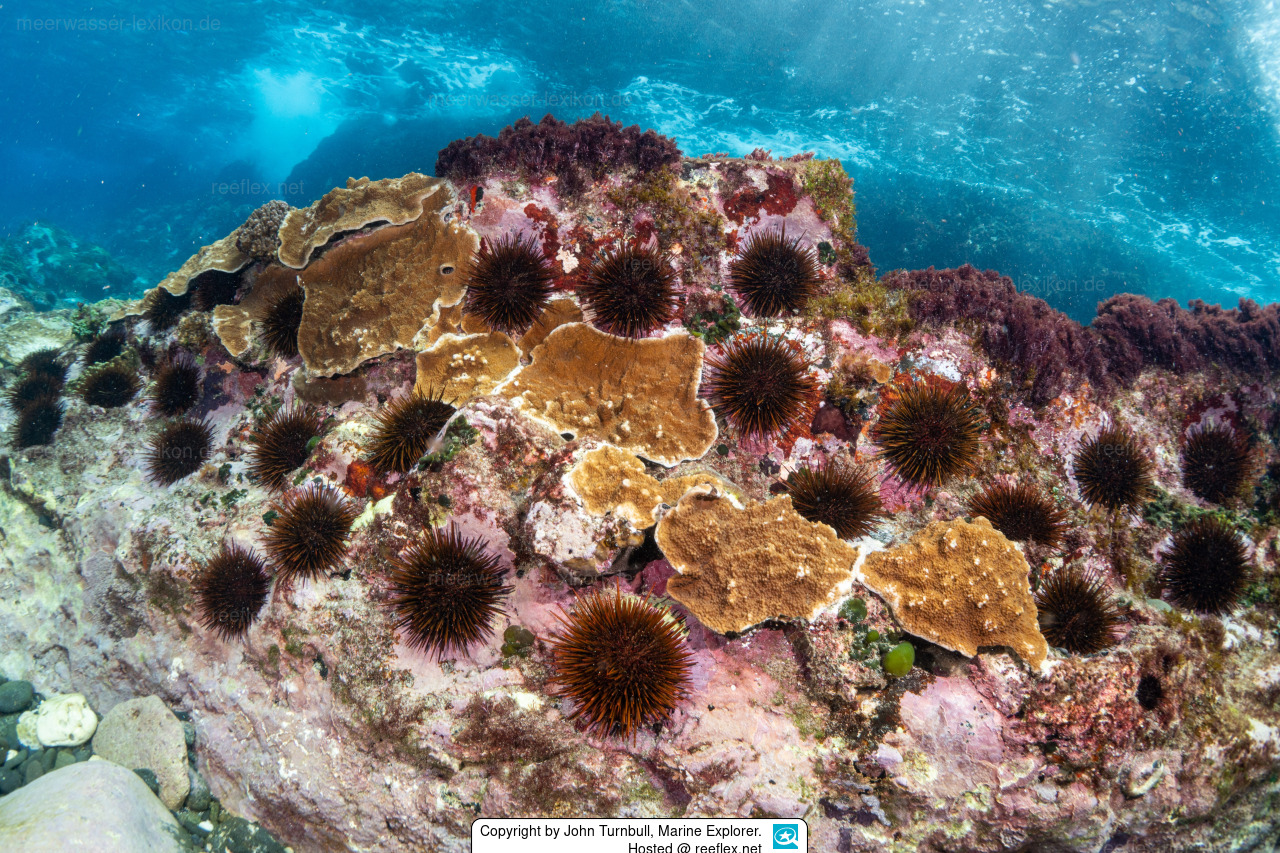Info
(Lamarck, 1816)
Heliocidaris tuberculata belongs to the family Echinometridae, the boring and stylet sea urchins, which actively work their way deep into the calcareous reefs and thus have a negative impact on reef stability.
This starfish lives on the algae and calcareous red algae present in the reef. Aquaristically, this sea urchin currently plays no role, but is nevertheless an economic factor, as it is used for human consumption.
Up to 15 tons of this sea urchin are harvested annually in New South Wales on the east coast of Australia.
To illustrate this quantity a little differently, these 15 tons correspond to 1,500,000 chocolate bars of 100 grams each.
Between 2006 and 2010, the number of Heliocidaris tuberculata sea urchins in Australia doubled, making Heliocidaris tuberculata the second most common sea urchin, with the sea urchin Centrostephanus rodgersii (A. Agassiz, 1864) taking first place.
This is certainly pleasing from a fishing point of view, but too many sea urchins have a major impact on reef systems due to overgrazing of important algae, and it was also noted that the populations of the blue fish Pomatomus saltatrix (Linnaeus, 1766) declined in parallel with the growth in the urchin population.
Another example of the need to keep nature in balance.
In addition to fishing pressure, the sea urchins suffer silently but intensively from the acidification of the sea, the structure of their calcareous skeleton becomes increasingly difficult, existing calcareous skeletons become thinner and more unstable, and the cells, tissue and organs of the hedgehogs are also damaged.
In addition, sexual reproduction suffers due to less active and slower sperm, which leads to significantly lower fertilization success and also endangers early larval stages.
A vicious circle in which many other species besides the sea urchins suffer (e.g. cuttlefish, corals,
Synonyms:
Anthocidaris homalostoma (Valenciennes, 1846)
Echinus omalostoma Valenciennes, 1846
Echinus tuberculatus Lamarck, 1816
Heliocidaris omalostoma (Valenciennes, 1846)
Heliocidaris tuberculatus (Lamarck, 1816)
Strongylocentrotus tuberculatus (Lamarck, 1816)
Toxocidaris homalostoma (Valenciennes, 1846)
Toxocidaris tuberculatus (Lamarck, 1816)
Classification: Biota > Animalia (Kingdom) > Echinodermata (Phylum) > Echinozoa (Subphylum) > Echinoidea (Class) > Euechinoidea (Subclass) > Carinacea (Infraclass) > Echinacea (Superorder) > Camarodonta (Order) > Echinidea (Infraorder) > Odontophora (Superfamily) > Echinometridae (Family) > Heliocidaris (Genus) > Heliocidaris tuberculata (Species)
Heliocidaris tuberculata belongs to the family Echinometridae, the boring and stylet sea urchins, which actively work their way deep into the calcareous reefs and thus have a negative impact on reef stability.
This starfish lives on the algae and calcareous red algae present in the reef. Aquaristically, this sea urchin currently plays no role, but is nevertheless an economic factor, as it is used for human consumption.
Up to 15 tons of this sea urchin are harvested annually in New South Wales on the east coast of Australia.
To illustrate this quantity a little differently, these 15 tons correspond to 1,500,000 chocolate bars of 100 grams each.
Between 2006 and 2010, the number of Heliocidaris tuberculata sea urchins in Australia doubled, making Heliocidaris tuberculata the second most common sea urchin, with the sea urchin Centrostephanus rodgersii (A. Agassiz, 1864) taking first place.
This is certainly pleasing from a fishing point of view, but too many sea urchins have a major impact on reef systems due to overgrazing of important algae, and it was also noted that the populations of the blue fish Pomatomus saltatrix (Linnaeus, 1766) declined in parallel with the growth in the urchin population.
Another example of the need to keep nature in balance.
In addition to fishing pressure, the sea urchins suffer silently but intensively from the acidification of the sea, the structure of their calcareous skeleton becomes increasingly difficult, existing calcareous skeletons become thinner and more unstable, and the cells, tissue and organs of the hedgehogs are also damaged.
In addition, sexual reproduction suffers due to less active and slower sperm, which leads to significantly lower fertilization success and also endangers early larval stages.
A vicious circle in which many other species besides the sea urchins suffer (e.g. cuttlefish, corals,
Synonyms:
Anthocidaris homalostoma (Valenciennes, 1846)
Echinus omalostoma Valenciennes, 1846
Echinus tuberculatus Lamarck, 1816
Heliocidaris omalostoma (Valenciennes, 1846)
Heliocidaris tuberculatus (Lamarck, 1816)
Strongylocentrotus tuberculatus (Lamarck, 1816)
Toxocidaris homalostoma (Valenciennes, 1846)
Toxocidaris tuberculatus (Lamarck, 1816)
Classification: Biota > Animalia (Kingdom) > Echinodermata (Phylum) > Echinozoa (Subphylum) > Echinoidea (Class) > Euechinoidea (Subclass) > Carinacea (Infraclass) > Echinacea (Superorder) > Camarodonta (Order) > Echinidea (Infraorder) > Odontophora (Superfamily) > Echinometridae (Family) > Heliocidaris (Genus) > Heliocidaris tuberculata (Species)







 Dr. John Turnbull, Marine Explorer, Australien
Dr. John Turnbull, Marine Explorer, Australien





